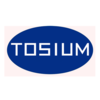國產(chǎn)核用不銹鋼輻照損傷研究國產(chǎn)核用不銹鋼輻照損傷研究STUDY OF IRRADIATION DAMAGE IN DOMESTICALLY FABRICATED NUCLEAR GRADE STAINLESS STEEL 采用2 MeV質子束在360 ?C對國產(chǎn)核用304不銹鋼試樣進行了輻照實驗,利用顯微硬度儀,透射電子顯微鏡(TEM)和三維原子探針(3DAP)等研究了材料的輻照損傷,分析了輻照劑量對輻照損傷演化的影響規(guī)律。結果表明,304不銹鋼輻照損傷微觀結構以位錯環(huán)和少量孔洞為主,位錯環(huán)的數(shù)量密度為1022 m-3量級,平均尺寸小于10 nm。材料在晶界和位錯環(huán)處發(fā)生元素偏析,其中Cr、Ni在晶界和位錯環(huán)處偏析程度相近,而Si在位錯環(huán)處的偏析程度數(shù)倍于晶界。位錯環(huán)平均尺寸和數(shù)量密度、晶界偏析程度以及輻照硬化程度均隨輻照劑量增加而增加,并在3-5 dpa范圍內趨于飽和。 The radiation-induced segregation (RIS) and microstructure evolution such as dislocation loops and cavities are major microstructural causes for the irradiation-assisted stress corrosion cracking (IASCC) of austenitic stainless steel (SS) core components. While a couple of studies have been reported on the irradiation induced damage in nuclear grade (NG) austenitic SS, the evolution of dislocation loop density and size and its correlation with the mechanical properties have still remained incompletely understood. In addition, the correlation between the segregation at the grain boundary and that at the dislocation loop has received limited attentions. In particular, there is still a lack of a systematic study of the irradiation damage in domestically fabricated NG austenitic SS. In this research, the proton-irradiation induced microstructural damage in domestically fabricated 304NG SS was characterized, in an effort to correlate the RIS and the dislocation loop density and size with the irradiation dose, as well as the dislocation loop density and size with the radiation-induced hardening. The results revealed that the radiation-induced microstructure damage was mainly dislocation loops with a few micro-voids. The loop density was in the order of 1022 m-3 with an average size of <10 nm. The square root of the product of loop density and size (Nd)^0.5, scaled linearly with the square root of irradiation dose with a factor of (6.8×10^3 ) (dpa)-0.5 /mm. The loops were believed to be mainly responsible for the hardening in 304NG SS, which also scaled linearly with (Nd)^0.5 with a factor of (1.16×10^(-2)) kg/mm. A comparative analysis about the segregation at the grain boundary and at the dislocation loop was conducted. While the depletion of Cr and enrichment of Ni at the dislocation loop and grain boundary showed no difference, the enrichment of Si at the dislocation loop could be of about 6 times of that at the grain boundary. In addition, the loop density and loop size, as well as RIS and radiation-induced hardening were all increased by a higher dose and tended to saturate by a dose of 3-5 dpa. 全文下載:http://pan.baidu.com/s/1eR1CCpk
|







